News of the Week; February 24, 2021
INTELLECTUAL PROPERTY
- Canadian consultation on extending the general term of copyright open through March 12
- Extra, extra, read all about it: new Canadian Bill proposes remuneration for use of journalistic works online
- Time to Pay the Copyright Piper? A Digital Media Platform Copyright Reckoning for Journalists is Upon Us!
- Meghan Markle gets summary judgment – but is she the sole author of her letter?
- Duchess of Sussex wins summary judgment in copyright and privacy claims
- Duchess of Sussex v Mail on Sunday & MailOnline
- HHJ Hacon decides ownership of Virtual Forensic Computing software created during course of employment.
- Karma: Twitch Replaces Live Metallica Concert With 8-Bit Music To Avoid Copyright Madness
- Understanding the Boundaries of Using Copyrighted Learning Materials in Distance Learning
- Hooray for the Public Domain: A prequel to The Great Gatsby sees the light of day!
- A Closed Book: No Past Infringement, No Reading Between the Lines into the Future
- Third circuit panel revises half-baked trade dress functionality decision
- 9th Circuit swivels on trade dress functionality doctrine in favor of iconic Herman Miller office chairs
- Apple Settles Trademark Opposition With PrePear Recipe App After The Latter Makes A Barely Perceptible Change In Logo
- A Registration is a Trump Card
- Peloton Seeks To Invalidate ‘Spinning’ Trademark Held By Trademark Bully
- FyreTV Porn Service Asks 11th Circuit Panel To Resurrect Dumb Trademark Suit Against Amazon Over FireTV
- USPTO Provides Guidance in View of ‘Booking.com’
- Trademark registrability of generic.com domain names following US Supreme Court decision on Booking.com
- Fairtrade Fortnight
- Protecting product appearance through trademark and design registrations
- Domain Name Dispute Resolution Options: Features, Benefits and Other Considerations for Selecting Between UDRP and URS
- Federal Circuit Clarifies When Appellate Review Triggers Patent Term Adjustment
- Federal Court Dismisses Limitation Period Defence in Patent Infringement Action under Section 8.2 of the PM(NOC) Regulations
- Canadian courts are interpreting supplementary pharmaceutical patent protection more broadly than their EU counterparts
- Lack of enablement in Amgen v Sanofi and Regeneron
- Federal Circuit Axes Amgen Antibody Patents, Finding Lack of Enablement
- Judge Schofield Rejects Application of Rare Equitable Estoppel Defense
- 2G or Not 2G: Patent License Applies to Future Generation Wireless Networks
- Boom in M&A shifts semiconductor patent landscape
- Patent Office Issues Guidance on Indefiniteness
- When is someone “authorised” to use a patented invention for the services of the Crown and therefore immune from patent infringement?
- John Deere Promised To Back Off Monopolizing Repair. It Then Ignored That Promise Completely.
- California can enforce net neutrality law, judge rules in loss for ISPs
- California Poised To Defeat Broadband Industry In Scrum Over Net Neutrality
- ‘Net Neutrality Hurt Internet Infrastructure Investment’ Is The Bad Faith Lie That Simply Won’t Die
- FCC Pressured To Let Libraries Bridge Broadband Access During The Pandemic
- China blocks BBC World News in Tit-for-tat move following CGTN Ban in UK
- Ontario Court Sets Out New Tort of “Harassment in Internet Communications”
- Facebook to reverse Australia news ban after lawmakers alter bill
- Facebook Caves To Australia: Will Restore Links After Government Gives It More Time To Negotiate Paying For News Links
- Right to post: Australia calls Facebook blocks an assault on a sovereign nation: Health Minister Greg Hunt has turned up the rhetorical dial after Facebook blocked Australian news media this morning.
- Facebook news ban is “arrogant,” Australia will not be “intimidated,” PM says
- The Bizarre Reaction To Facebook’s Decision To Get Out Of The News Business In Australia
- Why Is Facebook’s Decision to Restrict News in Australia So Significant?
- Australian News Sites Shocked & Upset To Learn They Don’t Need To Rely On Facebook For Traffic!
- Facebook’s Australian News Ban Did Demonstrate The Evil Of Zero Rating
- Beware the Unintended Consequences: Some Warning Signs for Canada from the Australian Government Battle With Facebook (Michael Geist)
- The Complexity of Internet Content Regulation – A Conversation with CIPPIC’s Vivek Krishnamurthy (Michael Geist)
- Microsoft throws Google under the bus in European news fight
- YouTube Removes PewDiePie’s Cocomelon Diss Track, Citing Harassment And Child Safety Policies
- Is Mandated Sideloading The Answer To App Store Deplatforming?
- Indian Government Requires Educational Establishments To Obtain Its Approval For The Subject Matter And Participants Of International Online Conferences And Seminars
- Tech groups sue Maryland to block new digital-ad tax from going into effect
- Is Section 230 Just For Start-ups? History Says Nope
- North Dakota’s New Anti-230 Bill Would Let Nazis Sue You For Reporting Their Content To Twitter
- Attacks On Internet Free Speech In Malaysia And Indonesia Demonstrate Why Section 230 Is So Important
- Content Moderation Case Study: Senator Asks YouTube To Block Al Qaeda Videos (2008)
- Content Moderation Case Study: Chatroulette Leverages New AI To Combat Unwanted Nudity (2020
- Doctor Can’t Win Default Judgment Over Patient’s Yelp Review–Mirza v. Amar (Eric Goldman)
- Maryland First State to Adopt Digital Ad Tax
- YouTube Shutters 7 Remaining ‘YouTube Spaces’ Globally, Doubling Down On Pop-ups And Virtual Programming
- Spotify Will Enable Podcasters To Charge For Monthly Subscriptions, Slates Broader Rollout For Video Podcasts
- Internationalized domain names: definition, challenges, and status
- Copyright in works created by artificial intelligence: issues and Perspectives
- Artificial Intelligence and Patents: Inventing Inventors
- Takeaways | Requiring Human Inventorship – Opportunities to Advise Whether to Prohibit, Permit, or Require Listing an AI Algorithm as an Inventor – Eastern District of Virginia & European Patent Office
- Legal Aspects of Artificial Intelligence (v3.0)
- AI can write a passing college paper in 20 minutes: Natural language processing is on the cusp of changing our relationship with machines forever.
- Microsoft says SolarWinds hackers stole source code for 3 products
- To pay or not to pay: Another regulator weighs in on the decision to pay a ransom
- LAPD Asked Ring Users To Turn Over Footage Of Anti-Police Brutality Protests
- Illinois politician proposes a Grand Theft Auto ban
- New Illinois Bill Would Expand Restrictions on Video Games
- UK antitrust tribunal blocks Epic’s case against Apple
- Epic Games attacks Apple in antitrust complaint to EU: Apple’s position as a gatekeeper for what apps can appear on iPhones or iPads has already attracted EU antitrust scrutiny
- Valve gets dragged into Apple and Epic’s legal fight over Fortnite
- Apple turns to Valve for information in legal battle with Epic
- Valve pushes back against Apple’s attempt to rope it into the big Epic v. Apple dispute
- Bethesda faces lawsuit over Fallout 4 DLC: The company faces charges of deceit for not including its Creation Club in the game’s Season Pass, which could delay Microsoft’s ZeniMax takeover
- Microsoft Unveils Xbox Accessibility Guidelines Version 2.0
- PS5 DualSense drift — this teardown just revealed the cause
- CD Projekt Red issues DMCA to prevent spread of stolen Gwent code
- CD Projekt issues DMCA takedowns to halt spread of illegally obtained source code
- Report: Some CD Projekt devs unable to work after ransomware attack
- Take-Two DMCA takes down reverse-engineered GTA source code
- Take-Two reportedly takes down reverse-engineered GTA3, Vice City source code
- Steam’s new controller reporting lets devs know how their games are played
- Burning Crusade Classic leaks ahead of BlizzCon
- Microsoft’s accessibility guidelines are a great start — but we can go further | Opinion
- Unity report shows mobile games ad revenue grew 8% in 2020
- January digital games spending reaches $11.6bn
- Notre Dame sitting out of EA Sports College Football for now
- Bungie scaling up to expand Destiny ‘into additional media’ and create new IPs
- Live-action Twisted Metal TV series moving forward
- Cambrian’s new game design program launches in September
- Sony developing ‘next-generation VR system’ for PlayStation 5
- Sony announces new PSVR hardware for PlayStation 5
- Sony just confirmed PSVR 2 for PS5 — these are the biggest upgrades
- Next-Gen VR Dev Kits for PS5 Shipping Soon with “completely new VR format”
- Sony Confirms Next-Gen PSVR is Coming, New Controllers to Feature DualSense Tech
- PlayStation’s commitment is a huge boost to the VR market | Opinion
- Carmack: Facebook-Oculus Acquisition ‘Not A Perfect Outcome’ But Still ‘Correct’ For The Company
Jon
News of the Week; February 17, 2021
INTELLECTUAL PROPERTY
- A consultation on how to implement an extended general term of copyright protection in Canada (Canada)
- Copyright Term Extension – March 12 2021 Deadline to Respond to Very Disappointing Document (Howard Knopf)
- Afraid to Lead: Canadian Government Launches Timid Consultation on Implementing Copyright Term Extension (Michael Geist)
- The Copyright Bill That Does Nothing: Senate Bill Proposes Copyright Reform to Support Media Organizations (Michael Geist)
- Copyright Term Extension: To Life Plus 70 Years, But Not Beyond! Government Consultation on Copyright Term Extension Now Open
- Should We Require Human Inventorship? Submit Your Amicus Brief by March
- Is This Beverly Hills Cop Playing Sublime’s ‘Santeria’ to Avoid Being Live-streamed?: Police in Beverly Hills have been playing music while being filmed, seemingly in an effort to trigger Instagram’s copyright filters.
- Copyright and database rights in database schema: Software Solutions Ltd and others v 365 Health and Wellbeing Ltd and Smith
- Judiciary’s Approach to Moral Rights under Copyright Law
- H&M and Unicolors weave up at Copyright battle at US SC
- UK Courts find hidden voice in film authorship dispute
- Pan-European Design Protection: Considerations for the fashion sector post-Brexit
- Utah Theme Park Sues Taylor Swift Over Album Title After Exploiting It
- A Shoe-In? Fleet Feet Gives Injunction Appeal the Moot Boot
- Amazon keeps hitting the target… but not quite in a trade mark context
- One too many Pink Ladies
- Tefal fails to secure trade mark protection for its red dot despite survey evidence
- ‘It’s like milk but made for humans’: General Court overturns EUIPO’s refusal to register Oatly’s trade mark
- When is a slogan a trade mark?
- Random Jackass Attempts To Trademark ‘Mayor Of Mar-A-Lago’ In The Most Hilarious Way
- How life sciences companies can strengthen IP strategies through the use of trade secrets
- ITC Finds Trade Secret Misappropriation and Bars Electric Vehicle Batteries from SK Innovation—With Exceptions
- $6 Million Verdict Vacated in Flooring Tech Trade Secrets Row
- The Facts on Fax Machines: They’re Not Dead, They’re Indefinite
- Foreign Prosecution History: To Admit, Or Not To Admit, That Remains a Puzzle To Canadian Courts
- Federal Court finds silodosin formulation patent valid but not infringed
- Patent application extensions of time in Canada
- Extensions of time in Canada: worth the trouble?
- Contradictory Positions Render Claims Indefinite
- “Safe Harbor” Act May Save Pfizer From Infringement for Covid Vaccine Clinical Trials
- It Is Improper To Read a Claim in a Grammatically Incorrect Way Simply To Include a Disclosed Embodiment
- US patents: Body blow for antibodies
- There’s no such thing as an international patent
- Everyday IP — Flushing out the facts: When was indoor plumbing invented?
- From Snail Mail to Streaming: The Netflix Intellectual Property Story
- Cloud Contracts: The Impact of Common Terms of Service Provisions on Intellectual Property Rights
- The link between intellectual property rights and business performance
- IP law looms large over U.S.-China relations
- Why Laid Off Bell Sports Journalists Should Form A Worker Co-op: We cannot rely on legacy corporate media to save the journalism industry. It’s time to build something better.
- Circumventing Parliament: How Bill C-10 Dramatically Reduces Parliamentary Oversight and Review Over Broadcast Policy (Michael Geist)
- Are Social Media Services “State Actors” or “Common Carriers”? (Eric Goldman)
- Dumb New GOP Talking Point: If You Restore Net Neutrality, You HAVE To Kill Section 230. Just Because!
- A reckoning for the paparazzi and tabloid media
- Facebook goes nuclear, banning all news posts in Australia
- Big Tech opens wallet for publishers as Australian news code looms
- Google and Facebook grapple with news publishers, as Australia becomes a test case
- The Internet Is Splintering
- Posing as Amazon seller, consumer group investigates fake-review industry
- There won’t be blood: Apple is making its syringe emoji a vaccine dose
- State lawmakers override veto, become first in nation to tax online ads
- Biden Administration Presses Pause on WeChat and TikTok Appeals
- Biden Administration Asks Federal Courts to Pause TikTok and WeChat Cases
- Twitter CFO Says Trump Is Banned In Perpetuity, Even If He Runs For Office Again
- Facebook has been helping law enforcement identify Capitol rioters
- Facebook Blocks News Viewing, Sharing In Australia, Faces Backlash From Emergency Services
- Zuckerberg responds to Apple’s privacy policies: “We need to inflict pain”: Meeting between Zuckerberg, Cook “resulted in a tense standoff.”
- Insights: Apple And Facebook Are Fighting For The Future As Much As For Now
- Inside the Making of Facebook’s Supreme Court: The company has created a board that can overrule even Mark Zuckerberg. Soon it will decide whether to allow Trump back on Facebook.
- The Copia Institute To The Oversight Board Regarding Facebook’s Trump Suspension: There Was No Wrong Decision
- Zuckerberg’s Grand Illusion: Understanding The Oversight Board Experiment
- United States: towards the end of Internet intermediary immunity?
- New details emerge about Google’s payments to link to French news sites
- Why young designers are using social media to shame fast fashion copycats
- Orrin Hatch, Who Once Wanted To Destroy The Computers Of Anyone Who Infringed On Copyrights, Now Lies About Section 230
- Content Moderation Case Study: Valve Takes A Hands Off Approach To Porn Via Steam (2018)
- Content Moderation Case Study: Google ‘Removes’ German Residences From Street View By Request (2010)
- Section 230 Protects App Store from Liability for Apps With Loot Boxes–Coffee v. Google (Eric Goldman)
- Section 230 Applies to Articles by Huffington Post Contributors–Page v. Oath (Eric Goldman)
- WhatsApp messages – who is in control?
- YouTube’s ‘Shorts’ TikTok Clone, With 3.5 Billion Daily Views, To Arrive In The U.S. This March
- YouTube Launches Bi-Weekly ‘Shorts Report’ To Bolster Its TikTok Competitor
- TikTok’s U.S. Ad Business Grew 500% In 2020, It Says
- SAG-AFTRA Ratifies New ‘Influencer Agreement’ Covering Creator-Generated Branded Content
- Disney+ Closes 2020 With 94.9 Million Subscribers, Expects To Hit 230 Million In 2024
- An anniversary for great justice: Remembering “All Your Base” 20 years later
- IP law and strategy for AI – A European perspective
- Top Ten Legal Considerations for Use and/or Development of Artificial Intelligence in Health Care
- Enough is enough — Governing the ungovernable
- FTC Settles Facial Recognition Data Misuse Allegations with App Developer
- he Perfect Storm for Privacy and Adtech: How the End of the Cookie Era Will Reshape the Digital Marketplace
- Information Commissioner confirms conservatives illegally collected data to racially profile voters
- Nintendo reportedly raises damages sought in Colopl lawsuit to $47m
- Nintendo claims additional damages in White Cat Project lawsuit
- Epic Games’ Case Against Teenage Fortnite Cheater Finally Settles
- Epic files EU antitrust complaint against Apple
- Fortnite vs. Apple continues to escalate with new antitrust complaint
- Fortnite fight expands as Epic claims Apple broke EU competition law
- North Dakota lawmakers jump into Apple/Epic fight with new app store bill
- Coalition for App Fairness behind North Dakota bill against Apple: Money from the organisation co-founded by Epic Games paid for lobbyists to introduce new bill into state senate
- A North Dakota bill aiming to loosen Apple’s tight grip on iOS has failed
- One Patent To Rule Them All | Podcast: We discuss the implications of Warner Bros’ Nemesis system patent, with Harbottle & Lewis’ Kostya Lobov
- PC versions of Grand Theft Auto reverse-engineered to raw source code
- Hackers claim to have sold Cyberpunk 2077, Witcher 3 source code
- CD Projekt Red source code reportedly sells for millions in dark Web auction
- How close is too close? A look into the use of altered trade marks and third-party ‘patches’ in videogames
- Eximius dev relaunching title after publisher dispute
- US game spending up 42% in January, says NPD
- Zynga delivers record annual revenues thanks to ‘forever franchises’
- Bad Robot looking to be the rare Hollywood-and-games success story
- Last Of Us HBO series casts Pedro Pascal as Joel
- Dota 2 is getting a Netflix series: The eight-episode anime series will launch on March 25
- The ‘GaaS or subscription service’ squeeze in games
- Blog: Video game music concerts in 2021
Jon
News of the Week; February 10, 2021
INTELLECTUAL PROPERTY
- Federal Court trusts technology to prove infringement
- Is This Beverly Hills Cop Playing Sublime’s ‘Santeria’ to Avoid Being Live-streamed?: Police in Beverly Hills have been playing music while being filmed, seemingly in an effort to trigger Instagram’s copyright filters.
- Latest Anti-Accountability Move By Cops Involves Playing Music While Being Recorded In Hopes Of Triggering Copyright Takedowns
- Celebrity tattoo artist Kat Von D sued for inking Miles Davis design? Tats crazy!
- Desire v. Manna Textiles (USCA, 9th Circuit): Holds only one statutory damages award available where defendant supplied infringing work to other defendants, even when those other defendants exploited infringing work.
- Carlini v. Paramount Pictures Corp. (USDC, California): Court action brought alleging film “What Men Want” infringed plaintiff’s screenplay, finding access was insufficient and works were not substantially similar.
- Be careful what you scrape from the HiQ v. LinkedIn decision
- Sherlock Holmes and the copyright infringement claim
- Protect your moves – A mix of Intellectual Property and Dance
- Snippet Taxes Not Only Violate The Berne Convention, But Also Betray The Deepest Roots Of Newspaper Culture
- Why Is Congress Pushing For Locking Up More Culture?
- SCOTUS Update – Google v. Oracle
- Music – Royalty Rates for Digital Transmissions
- Copyright year in review 2020
- The growing role of domains in IP
- What to Do when “Everything Sucks”
- Utah Theme Park Sues Taylor Swift Over Album Title After Exploiting It
- Taylor Swift sued by Utah Theme Park for trademark infringement.
- Pearl Jamm changes name to Legal Jam…to avoid legal jam
- SDNY Magistrate Judge Recommends that Rubik’s Cube Design is Not Functional
- Hanes Pop Warner’s Way: Trademark Dispute Over Pop Warner Mark
- How to Register a Common Shape as Your Trademark
- Trademarks in 2020: notable cases and developments
- Trade Secret Management in the United States: Top Ten Mistakes to Avoid
- December 2020 COVID-19 Relief Bill Finally Closes the Streaming Loophole
- Third Circuit Finds Pocky Trade Dress Functional, Not Protectable
- There’s No Sugarcoating It: Pocky’s Cookie Design Trade Dress Is Functional
- The Doctrine of File Wrapper Estoppel in Canada: The Court of Appeal Hands Down its Decision
- Evidence Supports Prior Art’s Public Accessibility but Not the Board’s Adoption of an Unpresented Theory of Anticipation
- Federal Circuit Clarifies Part of Patent Term Extension Equation
- Federal Circuit Says Automated Systems Are Not Abstract when Tied to Improvements
- The “Skinny Label” – The Federal Circuit Has Second Thoughts
- No Patent Eligibility Reward for Customer Loyalty Program Computer System
- How to patent over-the-air (OTA) automotive technology
- Federal Circuit Agrees to Reconsider Ruling in GSK v. Teva Drug Patent Case
- When Fixing One Problem Creates Another: How Patent Infringement Arises Out of Product Repairs
- Key Insights for Obtaining FinTech Patents
- Patents in 2020 – The year in review
- Conservative MP Files Amendment Calling on the Government to Withdraw Bill C-10 (Michael Geist)
- Why The Secrecy on Bill C-10?: How the Liberals Abandoned Their Commitment to Consultation, and Transparency in Pushing Their Broadcast Reform Bill (Michael Geist)
- Big Game, Ad Claims: Reflecting on Super Bowl Advertising Tactics
- 25 Years Later: A Celebration Of The Declaration Of The Independence Of Cyberspace
- Google, Facebook tell SCOTUS it should be harder for you to sue them
- Senators Warner, Hirono, And Klobuchar Demand The End Of The Internet Economy
- Platform mergers and antitrust: This paper sets out a framework for addressing competition concerns arising from acquisitions in big platform ecosystems.
- The Definitive Guide to Clickwrap
- We’re Living Our Lives On The Internet, And We Can’t Be Free If It Isn’t.
- Now It’s The Democrats Turn To Destroy The Open Internet: Mark Warner’s 230 Reform Bill Is A Dumpster Fire Of Cluelessness
- Senators Propose Substantial Revisions to Section 230’s Protections for Online Providers
- Proposed Sec. 230 rewrite could have wide-ranging consequences
- The Many Reasons To Celebrate Section 230
- Section 230 Lets Tech Fix Content Moderation Issues. Congress Should Respect That
- How To Think About Online Ads And Section 230
- How Section 230 Makes My Life Better (A Celebration of Its 25 Year Anniversary) (Eric Goldman)
- Content Moderation Case Study: Twitch Allows Users To Enable Emote-Only Chats (2016)
- Content Moderation Case Study: Twitter Attempts To Tackle COVID-related Vaccine Misinformation (2020)
- Universal Music Yanks Catalog From Triller, Slams Service For Withholding Artist Payments
- Texas Dept. Of Public Safety Issues Amber Alert For Victim Of Horror Doll Chucky
- 25 years ago today, the internet declared its independence — for better and for worse
- Protecting AI Innovations Through Trade Secrets and Patent Protection
- The Collision of AI’s Machine Learning and Manipulation: Deepfake Litigation Risks to Companies from a Product Liability, Privacy, and Cyber Standpoint
- Turf wars: confidentiality of live (sports) data
- Shadow of War publisher Warner Bros. has patented the series’ Nemesis system
- Super Nintendo World apparently took scenery from a Mario fangame
- G.I. Bro is a Go: Copyright Dispute Over Call of Duty Poster Survives Summary Judgement
- Activision Blizzard sued over Call of Duty character
- Warner Bros finally secures patent for Shadow of Mordor’s Nemesis system
- CD Projekt Red’s internal systems “compromised” following ransomware attack
- CD Projekt Red gets ‘cyberpunk’d’ – another ransomware attack
- Cyberpunk 2077 developer hit with ransomware attack
- Cyberpunk 2077 developer CD Projekt hit by ‘targeted cyber attack’
- MP proposes bill to make console scalping illegal amid PS5 and Xbox Series shortages
- Terraria developer cancels Google Stadia port after YouTube account ban
- Epic Games’ ability to go to war with Apple stems from its financial freedom, says CEO
- Epic’s new tool promises high-fidelity human characters in under an hour
- Epic Games’ new MetaHuman Creator will let devs build hi-fi humans
- EA Sports Announces College Football Video Game Revival and Another Collegiate Athlete Persona Rights Piece of Legislation is Proposed in Congress
- “90 bugs left”: Rare devs talk about the nearly completed Goldeneye 007 remake
Jon
News of the Week; February 3, 2021
INTELLECTUAL PROPERTY
- For the Want of a Nail – Copyright Claims Fail When Plaintiffs Can’t Show Ownership
- Thomson Reuters v. ROSS case will test limits on protections for subscription-based database: ROSS Intelligence alleges monopolistic, anticompetitive control over legal research market
- Bernie and his Marvelous Mittens. It’s all Good Fun Until a Copyright Lawyer Gets Involved
- Anthropomorphized Characters Representing Human Emotions are Not Copyrightable
- Annotations that Accompany State and Local Laws are not Copyrightable
- Generalized Expressions of Scientific Facts and Generic Themes are Not Copyrightable
- Spoofs, Parodies, Compatibility, and Comparisons: When Can Competitors Borrow from Each Other?
- Music – The Scope of Protection
- The Lies Told About The EU Copyright Directive’s Upload Filters May Help Get Them Thrown Out In Court
- Japan Looks To Amend Copyright Law To Force Some Cosplayers To Pay To Cosplay
- Pitch perfect appeal for James Arthur
- Is your joint copyright work purple or red/blue?
- Mitigating Copyright Issues in Remote Learning
- Music Licensing in the Video Streaming Era
- Pocky Ruling Denies Trade Dress Protection for the Useful, Though Not Essential, Shape of Cookie
- Third Circuit Panel Revises Half-Baked Trade Dress Functionality Decision
- Please Dough Not Use My Trademark
- Much ado about ballet shoes – important designs case on copying
- The Shape of Things to… Eat
- The Federal Court of Appeal Upholds Finding that Trademark Use Can Be Established Without a Physical Presence in Canada.
- Federal Court grants interlocutory injunction in trademark action for second time in six months
- Canadian Intellectual Property Office allows requests for expedited COVID-19 medical trademarks
- Taste, Smell, Hear, Touch, and See – Appealing to All Five Senses with Non-Traditional Trademarks
- Taylor Swift in ‘Evermore’ Trademark Lawsuit Over Utah Theme Park Name
- Trademark Modernization Act Strengthens Rights of Brand Owners
- The Trademark Modernization Act: Real Change to Address the Realities of Trademark Law
- Brewery Industry Insight — A Play-on-Words Mark Prevailed
- Annual Reminder: You Can Probably Just Call The Super Bowl The Super Bowl
- A decision based on Aesthetics – UK IPO rules stylisation is enough to overcome confusion
- General Court finds no likelihood of confusion in BBQLOUMI opposition – Cypriot cheesemakers continue to struggle in EU trade mark courts
- Lady A vs. Lady A: (Trademark) Battle of the Bands
- TTAB Precedent No. 46: No Abandonment of A.W. SHUCKS
- Cannabis Trade marks and commercialisation in the US, UK and EU.
- Minimalist trademarks: end of the road for uniqueness?
- Cybersquatting trends and strategies that brand owners need to know
- Janssen’s abiraterone acetate and prednisone combination therapy patent found invalid
- When is There an “Actual Invention” Involving Computers?
- Office Actions: Options to consider when you need an extension of time to respond to the Patent Office
- Protecting innovations through patent due diligence and FTO analysis
- Data Breaches Ain’t Just About Privacy: Risking the Loss of Patent Rights by Data Breach with Subsequent Disclosure
- All Hands On Deck: Ensuring Innovation, Not Just Patents, From All
- Third Circuit Requires Patent Validity Analysis In Adjudicating Antitrust Causation
- Federal Circuit Finds Patent Infringed After Reversing Claim Construction That Violated “Grammatical Principles” to Cover All Embodiments
- Judge Hellerstein Upholds Infringement by Microsoft of Kaufman’s “And/Or” Patent
- Augmented Reality/Virtual Reality Litigation Update: Defendants’ Motion to Stay Pending IPR Denied in AR Design Innovations’ Patent Case
- Update on Patent “Aggregation” Suit Against Fortress
- Patent-Eligible Subject Matter
- Patent-Ineligible Subject Matter
- 2020 IP Law Year in Review: Patents – Executive Summary
- Snapshot: intellectual property for fashion goods in Canada
- 14 States Are Now Considering ‘Right to Repair’ Legislation
- Is there Magic in those Mushrooms? Protecting Psilocybin and Other Actives from Magic Mushrooms
- IP Litigation 2020 Year in Review
- Antitrust Remedies in Highly Regulated Industries
- 27% Of Cable TV Subscribers Will Cut The Cord This Year
- How to Watch the Super Bowl in VR With Friends for Free
- Facebook Oversight Board decisions
- Apple, Its Control Over the iPhone, The Internet, And The Metaverse
- Apple’s updated App Store guidelines clarify positions on recent controversies
- Australians May Soon Face Life Without Google
- Microsoft backs Australian law forcing Google to pay for news links
- Continued Access to Service Not Sufficient to Bind User to New Terms of Service–Stover v. Experian (Eric Goldman)
- TripAdvisor Doesn’t Get Early Section 230 Dismissal–Putt v. TripAdvisor (Eric Goldman)
- No, Revoking Section 230 Would Not ‘Save Democracy’
- Removing Civil Rights Law From Section 230 Will Create Many New Problems, While Failing To Fix Existing Ones
- Columbia Law Professor Spews Blatantly False Information About Section 230 In The Wall Street Journal
- No Section 230 Has Nothing To Do With Horrific NY Times Story Of Online Stalker Getting Revenge For Decades’ Old Slight
- Content Moderation At Scale Is Impossible: Google Play Bans Video Player App Over ASS File Extension Support
- YouTube’s new “Clips” feature lets users share 60-second clips of videos
- YouTube Will Let Viewers Share Custom Short Videos Cut From Creators’ Uploads And Livestreams
- Teespring Goes Live With ‘Spring’ Rebrand, Has 450,000 Creators On The Platform
- Microsoft Patent: Chatbots Made From The Online Habits Of Dead People
- Patent Issues for Factory Automation Inventions in AI
- FTC’s allegations of misuse of facial recognition
- FTC Settles with Fertility-Tracking App Developer Regarding Health Data Disclosures
- States Gear Up to Limit Use of Biometrics and Biological Data
- Valve loses controller patent case, must pay $4m in damages
- Valve on the hook for $4 million over Steam Controller patent infringement
- Level Up: 33 Legal Tips for Game Developers and Publishers
- Amazon Can Make Just About Anything—Except a Good Video Game: The company produces successful movies, TV shows, e-readers and speakers, but gaming has proven difficult to crack.
- Report: Mismanagement plagues Amazon’s struggling push into video games
- Amazon is reportedly spending nearly $500 million a year on its video game division
- Activision bans 60,000 Call of Duty: Warzone cheaters
- Goldeneye 007’s lost Xbox 360 remaster has leaked—as a full-game speedrun
- Scalpers aren’t the main reason you can’t find a new console
- Activision Patent Seeks to Improve Esport Footage Sharing For Future Titles: A patent filed by Activision looks at ways to improve the esports experience with detailed data that could enhance the way broadcasts look.
- How to protect your intellectual property in the games industry
- Tabletop Simulator devs face criticism for Google Translate-sourced translations
- Piracy: Does it matter? – People will try to steal your game in huge numbers, says Butterscotch Shenanigans’ Adam Coster — treat it as a design constraint
- EA signs multi-year license extension with UEFA to continue FIFA collaboration
- Star Wars has made $3bn for EA
- EA has made $3 billion in net bookings from just Star Wars games
- EA Sports revives college football games, but without NCAA involvement
- EA is getting back into college football without NCAA, player licenses
- Animal Crossing: New Horizons sold over 31 million copies in nine months
- Super Nintendo World Recreated in Minecraft: A Minecraft player is currently building an authentic replica of the upcoming Super Nintendo World theme park, complete with its rides and shops.
- Modded Game Boy looks like an Apple product, works as Apple TV Remote
- 25 years later, Midway’s lost “MLB Jam” arcade game has been found
- AppOnboard nets $20 million to support ‘no-code’ mobile dev platform Buildbox
- Utility Patents – What Game Developers Should Know
Jon
News of the Week; January 27, 2021
INTELLECTUAL PROPERTY
- Software-Generated “Infringement Report” Supports $262,931 in Remedies For Copyright Infringement
- Securing Copyright and Trademark Rights for Broadcasts and Promotions Related to NFL Championship Games and Super Bowl LV (55)
- Sony Music Entertainment v. Cox Communications (USDC, Virginia: January 12, 2021): Denies ISP’s post-trial motion to reduce $1 billion statutory damages award in copyright infringement action.
- The Tricky Issue of Joint Authorship in Copyright Works
- BMG, Aggressive Champion Of Copyright Enforcement, Accused Of Copyright Infringement By Jehovah’s Witnesses
- CASE-ing the Joint: The Copyright Alternative in Small-Claims Enforcement Act
- Turns Out That Brexit Means Rotting Pigs’ Heads, And Losing An EU Copyright Exception
- Finds Alleged Parody Fails on Copyright Fair Use Factors but Passes Rogers Test to Avoid Trademark Liability
- Sports data rights in 2021: the outlook
- Trademarks in 2020: Notable Canadian trademark cases and developments
- Are Trademark Injunctions Continuing their Awakening from Hibernation?
- Top 5 trademark considerations every cleantech entrepreneur should know
- Pearl Jam v Pearl Jamm
- Proud to Be an American, God Bless The USA, But Not Functioning as A Trademark
- What’s Cookin’? No Likelihood of Confusion Between Two KITCHEN Marks
- Tommy Hilfiger invalidates trademark piggybacking on its iconic flag logo
- Brizzy v. Vizzy: Molson Coors Obtains Cheers-Worthy Trademark Ruling at Fifth Circuit
- “Lettuce Turnip the Beet” Pun on T-Shirts Not Trademark Use, Ninth Circuit Affirms
- Trademarks and Expressive Works
- Stay A Lot More Than Six Feet From The NFL’s Trademarks! 2021 Update on Super Bowl Advertising and Promotions
- Laches and Acquiescence in Trademark Proceedings
- More ‘failure to function’ refusals in 2020
- Generic.com Terms are Not Ineligible for Registration
- Trademark Law Updates – Fees, Fraud and Injunction Presumptions
- January 2021 Trademark Update
- US Trademark Amendment Act Will Provide New Procedures for Challenging Use Claims
- UDRP on Gameroom.com: Facebook keeps its domain name
- How does Brexit affect European Trademark Rights?
- Can I keep my .eu domain name?
- Who’s on the Line?: Protecting Your Trade Secrets on Zoom Calls
- Pepper Spray Manufacturer’s Successful Self-Defense Reinforces Best Practices for Design Patents
- Rothy’s v Giesswein – English Court leaves a lasting mark on EU Community design rights
- Federal Court of Appeal Cautions Against Use of Foreign Prosecution History
- Federal Court of Appeal affirms summary judgment in patent prosecutions: Court also upholds interpretation of file wrapper estoppel in precedent-setting case
- Federal Court continues trend of granting summary judgment in appropriate patent proceedings
- Federal Court upholds validity of two patents pertaining to ELIQUIS
- Non-practicing entity’s allegations of patent infringement against oil sands producer /operator dismissed
- Choueifaty patent application found to possess patentable subject-matter
- Federal Court finds silodosin formulation patent valid but not infringed
- Patent Appeal Board Allows Dosage Regimen Claims – No Physician Skill Needed
- PMPRB proposes to modify Guidelines definition of “gap medicine” to include medicines sold by July 1, 2021
- Patentee’s Success Story in a Hatch-Waxman Litigation Case
- A New Application of an Abstract Idea Is Still Abstract: Court Affirms Dismissal Under § 101
- Patentee Cannot Cure Lack of Written Description by Reference To Matter Present Only Foreign Priority Application
- Happiest Baby’s SNOO patent Rocks Baby Automatically
- Illuminating insufficiency: the English Patents Court examines “Regeneron ranges”
- Regeneron Recast – Mr Justice Birss provides illuminating insight into the law of sufficiency
- UKIPO “Green Channel” – can the patent system encourage more innovation in green technologies?
- Cannabis: Patents in Europe
- Senate Passed New Legislation to Punish Foreign Individuals and Corporations for IP Theft
- Biden administration promises hard stance against Chinese IP abuses
- Intellectual Property Issues for Foreign Enterprises Acquiring Chinese Companies
- Critical and curious terms from the world of Intellectual Property
- Top Enforcement Issues to watch in 2021
- Report calls for powerful new federal body to regulate social media
- YouTube Suspends Donald Trump Indefinitely, Demonetizes Rudy Giuliani
- This site posted every face from Parler’s Capitol Hill insurrection videos
- Insights: The Donald’s Digital Death Penalty—Deplatforming, Politics, And The Future Of Social Media
- California Appeals Court Says Section 230 Immunizes Twitter From Banned User’s Lawsuit
- Dozens Of Human Rights Group Tell Congress: Do Not Gut Section 230 On Our Behalf; It’ll Do More Harm Than Good
- Twitter is opening up its full tweet archive to academic researchers for free
- Have Social Media Companies Become Too Powerful?
- Planning to Sue Twitter Over an Account Suspension? YOU WILL LOSE–Murphy v. Twitter (Eric Goldman)
- EFF Tells Louisiana Court Satire Is Still Protected Speech Even If The Government Doesn’t Get The Joke
- Unfiltered: How YouTube’s Content ID Discourages Fair Use and Dictates What We See Online (EFF)
- Big Tech worldwide nerulation: not if, but how
- Google agrees to pay French news sites to send them traffic
- Google: We’ll shut down Australian search before we pay news sites for links
- Google Threatens To Pull Out Of Australia Entirely; Australians Demand That It Both Stay And Pay News Orgs For Giving Them Traffic
- Google takes Tilt Brush open source as official development comes to an end
- Why Red Hat killed CentOS—a CentOS board member speaks
- Antitrust and the Tech Industry
- House Republicans Have A Big Tech Plan… That Is Both Unconstitutional And Ridiculous
- How Can Conservatives Fight Back Against Big Tech? For A Start, Just Be Sane Again.
- FOSTA Survives Constitutional Challenge–US v. Martono (Eric Goldman)
- Comments on the “Protecting Constitutional Rights from Online Platform Censorship Act” (Eric Goldman)
- Content Moderation Case Study: Facebook Targets Misinformation Spread By The Philippines Government (2020)
- Content Moderation Case Study: Social Media Upstart Parler Struggles To Moderate Pornography (2020)
- Mirroring Qualifies for Section 230–Monsarrat v. Newman (Eric Goldman)
- The Number Of Channels Monetizing Via YouTube’s Partner Program Doubled In 2020, CEO Says
- TikTok Helps Push 17-Year-Old Olivia Rodrigo’s “Drivers License” To No. 1 Billboard Debut
- Valve’s Gabe Newell imagines “editing” personalities with future headsets: “Remember when Bob got hacked by Russian malware [and] ran naked through forests?”
- Research and analysis – Algorithms: How they can reduce competition and harm consumers (Competition & Markets Authority, U.K.)
- A short primer on patenting AI and machine learning inventions at the European Patent Office
- New Yorkers Receive Postmortem Rights and Protection Against Digitization of Sexually Manipulated Content in New Right of Publicity Statute
- Québec law firm files latest Nintendo Switch Joy-Con drift lawsuit: Lambert Avocat seeking compensation for all Québec consumers who bought Switch controllers since August 2017
- European Commission called to investigate into Joy-Con drift
- BEUC calls for Joy-Con Drift investigation after receiving 25,000 complaints
- Valve on trial for allegedly infringing controller patents: The Steam Controller is accused of being based on a patent belonging to SCUF
- US Court dismisses Wargaming lawsuit against former employees
- Jagex disputes Plutos Sama’s claims of ownership: RuneScape dev calls RICO lawsuit against former owner “meritless,” says it was fully acquired by Carlyle Group
- Epic’s Fortnite v Apple dispute arrives in the UK
- The Pokémon Company takes measures against Sword and Shield hackers
- The Pokemon Company is clamping down on Sword, Shield, and Home hackers
- Rovio quietly shutters game streaming service Hatch
- Games projects raised $23m on Kickstarter in 2020
Jon





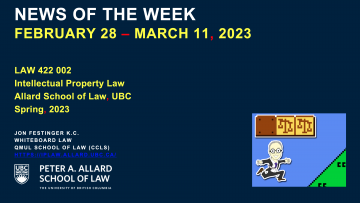


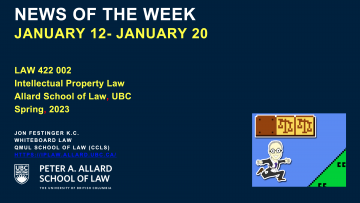
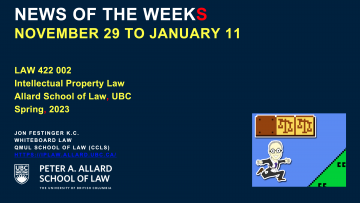
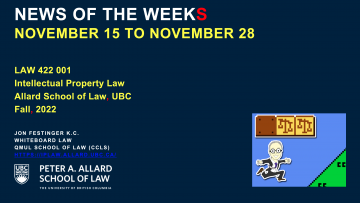
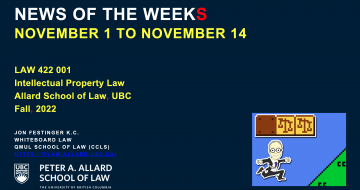
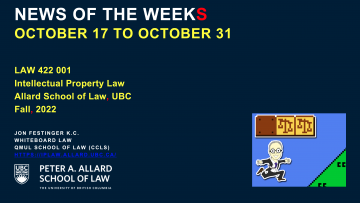

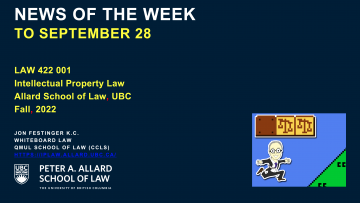
 Copyright & Social Media
Copyright & Social Media Communications Law
Communications Law